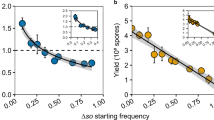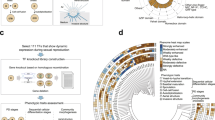Abstract
Tatum's and Beadle's1 investigations on Neurospora inspired me to attempt to induce physiological mutations in Ophiostoma multiannulatum (Hedge, and Davids.) by means of X-ray treatment. Normal strains of this fungus grew optimally on a synthetic medium containing glucose, ammonium tartrate, inorganic salts, aneurin (= vitamin B1) and pyridoxin (= vitamin B6)2. Out of 775 monosporous mycelia which were obtained from X-ray treated ascospores by means of a special procedure3, 12 (that is, 1·6 per cent) differed physiologically. The manner in which they differed is shown in the accompanying table.
This is a preview of subscription content, access via your institution
Access options
Subscribe to this journal
Receive 51 print issues and online access
$199.00 per year
only $3.90 per issue
Buy this article
- Purchase on Springer Link
- Instant access to full article PDF
Prices may be subject to local taxes which are calculated during checkout
Similar content being viewed by others
References
Beadle G. W. and Tatum E. L., Nat. Acad. Sci. Proc., 27, 499 (1941). Tatum E. L. and Beadle G. W., ibid., 28, 234 (1942). (only available in abstracts.)
Fries N., Symb. Bot. Upsal., 7, 2 (1943).
Fries N., Ark. Bot., 32, 4 (1945).
Volkonsky M., C.R. Soc. Biol. Paris, 109, 528 (1932).
Fildes P. and Richardson G. M., Brit. J. Exp. Pathol., 18, 292 (1937).
Author information
Authors and Affiliations
Rights and permissions
About this article
Cite this article
FRIES, N. X-Ray Induced Mutations in the Physiology of Ophiostoma. Nature 155, 757–758 (1945). https://doi.org/10.1038/155757a0
Issue Date:
DOI: https://doi.org/10.1038/155757a0
This article is cited by
-
Studies on the black rot of coffee
Proceedings / Indian Academy of Sciences (1954)
-
Mutations Induced in Coprinus fimetarius (L.) by Nitrogen Mustard
Nature (1948)
-
Experiments with Different Methods of Isolating Physiological Mutations of Filamentous Fungi
Nature (1947)
Comments
By submitting a comment you agree to abide by our Terms and Community Guidelines. If you find something abusive or that does not comply with our terms or guidelines please flag it as inappropriate.



